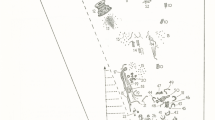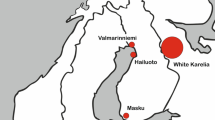Abstract—
An analysis of a fragment of Bronze Age textile found at the settlement of Kamenny Ambar in the South Urals is performed. Technological analysis makes it possible to establish that the textile was made from raw cotton, and the results of radiocarbon dating attributed it to the beginning of the II millennium BC. A comparative analysis of the textile fragment and the broad archaeological context of the early finds of ancient cotton fabrics suggests that the fabric could have been made in Pakistan or India and came to the South Urals along with migrants.





Similar content being viewed by others
REFERENCES
N. Shishlina, O. Orfinskaya, P. Hommel, E. P. Zazov-skaya, P. S. Ankusheva, and J. van der Plicht, Nanotechnol. Russ. 15, 629 (2020). https://doi.org/10.1134/S1992722320050143
N. I. Shishlina, Vestn. RFFI, 23 (2021). https://doi.org/10.22204/2587-8956-2021-103-01-23-38
Multidisciplinary Investigations of the Bronze Age Settlements in the Southern Trans-Urals (Russia), Ed. by R. Krause and L. N. Koryakova, Vol. 23 of Frankfurter Archäologische Schriften (Dr. Rudolf Habelt GmbH., Bonn, 2013).
The Bronze Age in the Karagaily-Ayat Region (Trans-Urals, Russia). Culture, Environment, and Economy, Ed. by L. N. Koryakova and R. Krause, Vol. 43 of Frankfurter Archäologische Schriften (Dr. Rudolf Habelt GmbH., Bonn, 2021).
L. Rühl, C. Herbig, A. Stobbe, et al., Vegetat. Hist. Archaeobot. 24, 413 (2015). https://doi.org/10.1007/s00334-014-0506-7
A. V. Epimakhov and R. Krause, in Multidisciplinary Investigations of the Bronze Age Settlements in the Southern Trans-Urals (Russia), Ed. by R. Krause and L. N. Koryakova, Vol. 23 of Frankfurter Archäologische Schriften (Dr. Rudolf Habelt GmbH., Bonn, 2013), p. 129.
L. N. Koryakova and S. A. Kuz’mina, Ural. Istor. Vestn., No. 1 (54), 92 (2017).
L. N. Koryakova, R. Krauze, S. V. Sharapova, et al., Istor. Nauki Tekh., No. 1, 22 (2018).
A. V. Epimakhov, S. E. Panteleeva, and L. N. Koryakova, Archaeol. Ethnol. Anthropol. Euras., No. 48, 95 (2020). https://doi.org/10.17746/1563-0110.2020.48.4.095-105
N. B. Vinogradov and N. A. Berseneva, Arkheol. Etnogr. Antropol. Evraz., No. 3 (55), 59 (2013).
P. J. P. George, “Intramural infant burials in the Aegean Bronze Age. Reflections on symbolism and eschatology with particular reference to Crete,” in Le Mort dans la ville. Pratiques, contextes et impacts des inhumations intra-muros en Anatolie, du début de l’Age du Bronze à l'époque romaine, Ed. by H. Olivier (Inst. Franç. Études Anatoliennes Georges Dumézil, Istambul, 2013), pp. 1–9.
T. N. Mishina, Kratk. Soobshch. Inst. Arkheol., No. 224, 136 (2010).
L. N. Koryakova and I. V. Molchanov, Vestn. Arkheol. Antropol. Etnogr., No. 4 (51), 17 (2020). https://doi.org/10.20874/2071-0437-2020-51-4-2
S. E. Ryan, V. Dabrowski, A. Dapoigny, et al., Sci. Rep. 11, 303 (2021). https://doi.org/10.1038/s41598-020-79675-3
Ch. Moulherat, J. Tengberg, and B. Mille, J. Archaeol. Sci., No. 29, 1393 (2002). https://doi.org/10.1006/jasc.2001.0779
A. Betts, K. van der Borg, A. de Jong, et al., J. Archaeol. Sci., No. 21, 489 (1994).
K. A. Chowdhury and G. M. Buth, Biol. J. Linn. Soc., No. 3, 303 (1971). https://doi.org/10.1111/j.1095-8312.1971.tb00524.x
N. I. Shishlina, O. V. Orfinskaya, and V. P. Golikov, Oxford J. Archaeol., No. 22, 331 (2003).
A. N. Gulati and A. J. Turner, J. Textile Inst. Trans., No. 20 (1), 1 (1929). https://doi.org/10.1080/19447022908661470
R. H. Meadow, in The Origins and Spread of Agriculture and Pastoralism in Eurasia, Ed. by D. R. Harris (UCL Press, London, 1996), p. 390.
D. Fuller, R. Korisettar, P. C. Venkatasubbaiah, et al., Veget. Hist. Archaeobot., No. 13, 115 (2004). https://doi.org/10.1007/s00334-004-0036-9
P. N. Doumani Dupui, P. N. Spengler III, and M. D. Frachetti, Quat. Int., No. 468, 228 (2018). https://doi.org/10.1016/j.quaint.2016.09.067
R. N. Spengler, L. Tang, A. Nayak, et al., Veget. Hist. Archaeobot., No. 30, 463 (2021). https://doi.org/10.1007/s00334-020-00798-8
E. Kvavadze, G. Narimanishvili, and L. Bitadze, Veget. Hist. Archaeobot., No. 19, 479 (2010). https://doi.org/10.1007/s00334-010-0270-2
P. M. Zhukovskii, Cultivated Plants and their Relatives (Kolos, Leningrad, 1964) [in Russian].
O. V. Orfinskaya, V. P. Golikov, and N. I. Shishlina, in Textiles of the Bronze Age of the Eurasian Steppes, Ed. by N. I. Shishlina, Tr. GIM (GIM, Moscow, 1999), No. 109, p. 58 [in Russian].
P. S. Medvedeva, O. D. Mochalov, and O. V. Orfin-skaya, Stratum Plus, No. 2, 345 (2017).
P. S. Ankusheva, O. V. Orfinskaya, L. N. Koryakova, et al., Ural. Istor. Vestn., No. 2 (67), 16 (2020). https://doi.org/10.30759/1728-9718-2020-2(67)-16-25
I. L. Chernai, Eneolithic and Bronze Age of the Ural-Irtysh Interfluve, Ed. by G. B. Zdanovich (Chelyab. Univ., Chelyabinsk, 1984), p. 93 [in Russian].
A. N. Usachuk and R. A. Litvinenko, in Abashevskaya Cultural and Historical Community: Origins, Development, Heritage, Proceedings of the International Scientific Conference, Ed. by V. S. Bochkarev (Chuvash. Gos. Inst. Gumanit. Nauk, Cheboksary, 2003), p. 163.
L. L. Gaiduchenko, Arkaim - Sintashta: The Ancient Heritage of the Southern Urals, Collection to the 70th Anniversary of G. B. Zdanovich, Ed. by D. G. Zdanovich (Chelyabinsk, 2010), Part 1, p. 201 [in Russian].
L. N. Koryakova and S. E. Panteleeva, Ural. Istor. Vestn., No. 3 (72), 39 (2021). https://doi.org/10.30759/1728-9718-2021-3(72)-39-49
A. V. Epimakhov, M. N. Ankushev, P. S. Ankusheva, et al., in Geoarchaeology and Archaeological Mineralogy, Ed. by A. M. Yuminov and N. N. Ankusheva (Yu.-Ural. GGPU, Miass, 2021), p. 10 [in Russian].
A. Stobbe, M. Gumnior, L. Ruhl, et al., The Holocen, 1–19 (2016). https://doi.org/10.1177/0959683616641740
F. N. Mil’kov and N. A. Gvozdetskii, Physical Geography of the USSR (Mysl’, Moscow, 1976) [in Russian].
G. Robbins Schug and H. M. Goldman, Am. J. Phys. Anthropol. 155 (2), 1 (2014). https://doi.org/10.1002/ajpa.22536
G. Robbins Schug, Bioarchaeology and Climate Change. A View from South Asian Prehistory (Florida Univ. Press, Florida, 2011).
M. Massa, in Regional Studies in Archaeology, Settlement Archaeology Symposium Proceedings YAS 4 (Istanbul, 2014), pp. 105, 106, 113, 114.
A. Guy, M. Brottrager, J. C. Cuaresma, et al., Glob. Environ. Change, No. 54, 239 (2019). https://doi.org/10.1016/j.gloenvcha.2018.12.003
A. V. Epimakhov and I. V. Chechushkov, Vestn. Tomsk. Univ., Istor., No. 54, 155 (2018). https://doi.org/10.17223/19988613/54/25
M. D. Frachetti, C. E. Smith, C. Trauba, et al., Nature (London, U.K.) 543, 193 (2017). https://doi.org/10.1038/nature21696
V. M. Narasimhan, Science (Washington, DC, U. S.) 365, 999 (1999).https://doi.org/10.1126/science.aat7487
A. Parpola, Stud. Orient. Electron. 8, 175 (2020). https://doi.org/10.23993/store.98032
D. Christian, World Hist. 11, 1 (2000).
V. A. Novozhenov, in Archeology of Kazakhstan in the Era of Independence: Results and Prospects, Proceedings of the International Scientific Conference, Dedicated to the 20th Anniversary of the Independence of the Republic of Kazakhstan and the 20th Anniversary of the Margulan Institute of Archeology KN MES RK (Almaty, 2011), p. 247.
ACKNOWLEDGMENTS
We are grateful to N.A. Berseneva for impeccable documentation during the excavation of wells and burials, as well as for ensuring the safety of the textile material, as well as to A. Mamonova for additional analysis of the cotton fibers.
Funding
The study of cotton textiles, radiocarbon dating, and interpretation of the results were supported by the Russian Science Foundation (grant no. 21-18-00026). The study of wells, burials of the Sintashta culture, interpretation of data were carried out on the topic “Ancient and medieval cultures of the Urals: regional features in the context of global processes” (state registration no. 121102500121-8).
Author information
Authors and Affiliations
Corresponding author
Ethics declarations
We declare that we have no conflicts of interest.
This article does not contain any studies involving animals or human participants performed by any of the authors.
Additional information
Translated by A. Bulaev
Rights and permissions
About this article
Cite this article
Shishlina, N.I., Koryakova, L.N. & Orfinskaya, O.V. Exotic Cotton Textile of the Bronze Age from the Southern Trans-Urals. Nanotechnol Russia 17, 691–700 (2022). https://doi.org/10.1134/S2635167622050159
Received:
Revised:
Accepted:
Published:
Issue Date:
DOI: https://doi.org/10.1134/S2635167622050159




